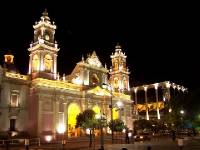Profile
Blog
Photos
Videos
Day 1 I took the Clouds tour through Santa Rosa de Tastil and San Antonio de los Cobres, through the Salt fields to Purmamarca, Juyuy.For lunch I had cabrito (goat) & shared w/ a guy from Barcelona who got the milanesa de llama or llama snitzel.They were both good - the llama meat was so thin that it didn't taste like much more than the breading.In the salt fields we took some awesome pictures then stopped at the highest point - 4170 meters ASL before reaching Purmamarca. The place I stayed also had a restaurant w/ a Peña, or live local music.The duet was really good & I filmed a lot.I also tried a llama empanada that was OK but a little dry & stringy.
My second day in the Argentinean state of Juyuy I took a walk around the 7 colors mountain.It was a nice walk w/ great colored views - the mountain really does have 7 colors!After that I took the bus to another little town called Tilcara.I took a tour to the Waira caves.My guide was a history professor and told me a lot about the history of Argentina, especially the area of the Quebrada de Humahuaca.The majority of the fighting against the Spanish took place in that area.Also the people of Humahuaca retain some of their Andean culture, much more similar to Bolivia than the more European rest of Argentina.He drew the pacha for me which forms their Andean cross. It combines the sun, air, water and soil w/ diagonals of time and space.They also see time as a spiral w/ an arrow at each end, they are not sure if they are going toward the beginning of all things or away from it.The spiral is divided into 4 quadrants alternating between positive and negative suns.They then further multiply these spirals into 4 spirals, each quadrant being a sun.Right now we are in the end of the fourth sun (negative time since the colonial invasion) entering into the 5th sun which is supposed to be more positive but during the time of changing of the suns it is a time of BIG changes.Like the Incas they celebrate June 21st, the inti raymi festival of the sun celebrating the beginning of winter and on Dec. 21st, the capaj raymi celebrating the beginning of summer.Another very important time is in August where they fertilize the earth in order to have a good growing season.It is at the end of the winter and they dig a hole in the ground & gather the 4 essential elements plus the best fruits of the last season that they have saved to give back to the earth, pacha.At this time they also unearth what was buried the year before and the abuelos that preside over everything predict what to grow during the next season, what will be good, if there will be draught etc. based on what happened to last years' offerings.This is called the Pacha mama and is very important especially in the countryside.It was a pretty steep walk up the hill across from Tilcaya and along the way we saw a land formation like a puma's head and a face/turtle as well as some remains of the houses of the early settlers of the area a long time ago.Then we went into the Waira cave (Quetchua for wind cave) and we had to shimmy sitting on a rock and moving our feet along to get in.Once we were in he lit a bunch of candles to light the way.It was very beautiful.After we got a ways in we sat and listened to the sound of silence for a few minutes.What an awesome experience!
Day 3 I started out in Tilcara walking for 1.5 hours to get to the Garganta del Diablo (devil's throat) which ended up being a very disappointing tiny waterfall!!The canyon was pretty though and the view of the colored mountains on the way back was nice.I then went to the Pukara which is a reconstruction of an early settlement there.I ran into Jini & Martin who I had met over a month earlier in Bariloche and since they had a car they very nicely not only took me back to the hostel but all the way to Humahuaca too!I was so thankful since I was tired & had a stomachache!!Along the way to the town of Humahuaca we passed the tropic of Capricorn (exactly 23.5degrees south of the equator!)After I hung out w/ them for a bit in the town they went back to Salta and I started walking 9km to a place w/ ruins called Coctaca.After an hour I was soooooooo happy to see the bus come by and take me the other half of the way there!Unfortunately I couldn't find the ruins and so I just saw some black sheep, got barked at by dogs and wandered around some rundown deserted looking properties before going back to the bus stop so as not to miss the only ride back home!There I talked to some local teachers though and that was interesting.
Day 4 I took a bus along a very curvy route which topped at over 4000m ASL to a little town in the state of Salta called Iruya.When I got to the town it was very cute, buried deep in a gorge.I walked around, enjoyed the quaintness and then spoke to a kindergarten teacher named Ester who let me come in and visit her students.They were so adorable!It was a 5 hour round trip to the town but it was worth it.
- comments




